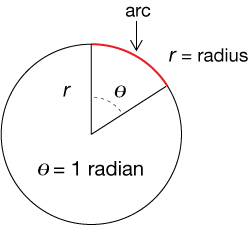Module 8—Mechanical Waves
 Explore
Explore
The following image shows a transverse wave similar to one that would be produced in the string of a musical instrument when it is disturbed.

Figure 1
A transverse wave is a sine curve, so called because it is like the graph of the sine function in trigonometry. The angle on the horizontal axis is referred to as the phase angle, and it describes the relative position of the waveform along the horizontal axis. In other words, the wave’s movement can be measured by a change in phase angle. For example, if the waveform in Figure 1 undergoes a negative 90° phase shift, it moves 90° to the right along the axis, as illustrated in Figure 2.

Figure 2
 Self-Check
Self-Check
SC 1. Draw a negative 180° phase shift for the same transverse waveform shown in Figure 1, and fill in the last two missing angles on the axis. Here is a printable copy of the diagram.
![]()
 Self-Check Answers
Self-Check Answers
SC 1. Your diagram should look like the following.

Using Radians to Measure Angles and Phase
You are probably familiar with using degrees to measure angles. Another measure that is frequently used in physics and mathematics is radian measure. You encountered it in Module 7: Lesson 1. Radians are just another way to measure angles. Conceptually, degrees or radians can be used to measure angles just like Canadian (Imperial) gallons or American gallons can be used to measure volume. An angle of 1 radian (rad) lies between two radii of a circle that cut off an arc on the circumference between them whose length is equal to the radius. Therefore,
1 rad = approximately 57.3°

This is how a radian is defined: If the arc on the circumference of a circle is equal in length to the radius of the circle, the angle between the arms of the arc is one radian. This is shown below. The length of the arc marked in red is equal to the circle’s radius. Angle (θ) is one radian.
Since a circle has a circumference defined by C = 2πr, rotating through an entire circle is the same as rotating through 2π radians. This gives the “conversion” factor between degree measure and radian measure:
2π radians = one complete rotation or 360°
π radians = 180°
 Module 8: Lesson 3 Assignment
Module 8: Lesson 3 Assignment
Remember to submit the answer to TR 1 to your teacher as part of your Module 8: Lesson 3 Assignment.
 Try This
Try This
TR 1. Complete the following graph using the radians-degrees conversion factor.

A Wave Phase and Interference simulation will be used to explore the concept of wave phase and how this relates to position.
When using the simulation, radian measure is used. When you enter a value for the phase (Φ) of a wave, radians will be used to calculate the horizontal position of the wave.
 Module 8: Lesson 3 Assignment
Module 8: Lesson 3 Assignment
Remember to submit the answer to TR 2 to your teacher as part of your Module 8: Lesson 3 Assignment.
 Try This
Try This
TR 2. Use the phase slider (![]() ) on the simulation to investigate how wave phase affects the position of a wave (the blue wave) as it is drawn along the horizontal axis of a graph.
) on the simulation to investigate how wave phase affects the position of a wave (the blue wave) as it is drawn along the horizontal axis of a graph.
- A negative phase or decrease in the phase shifts the wave to the ______________ along the horizontal axis.
- A positive phase or increase in the phase shifts the wave to the ______________ along the horizontal axis.
- Two waves will overlap exactly (i.e., match up) only when the phase of one of the waves is exactly 2π radians greater than the phase of the other wave. Is this statement true or false? Explain your answer.